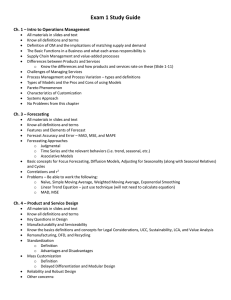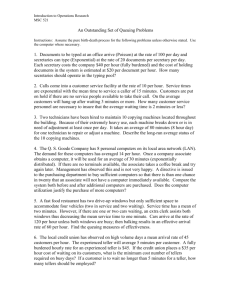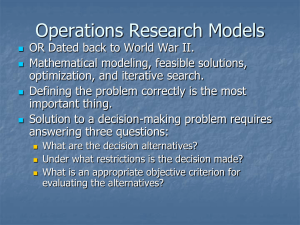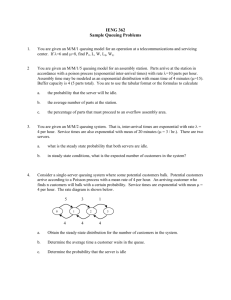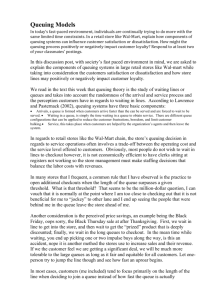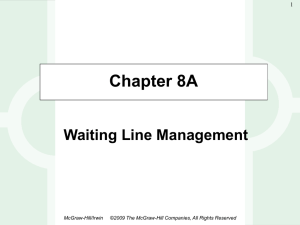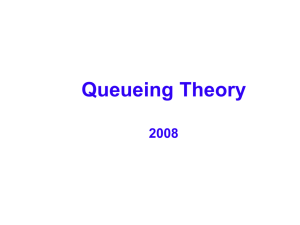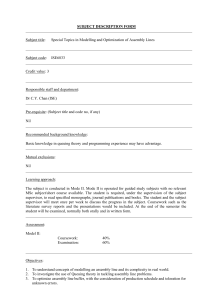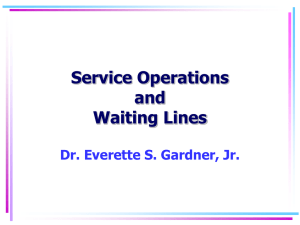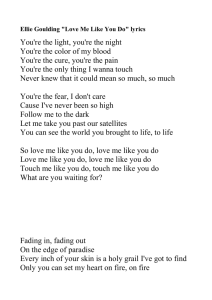The Single-Server Waiting Line System
advertisement
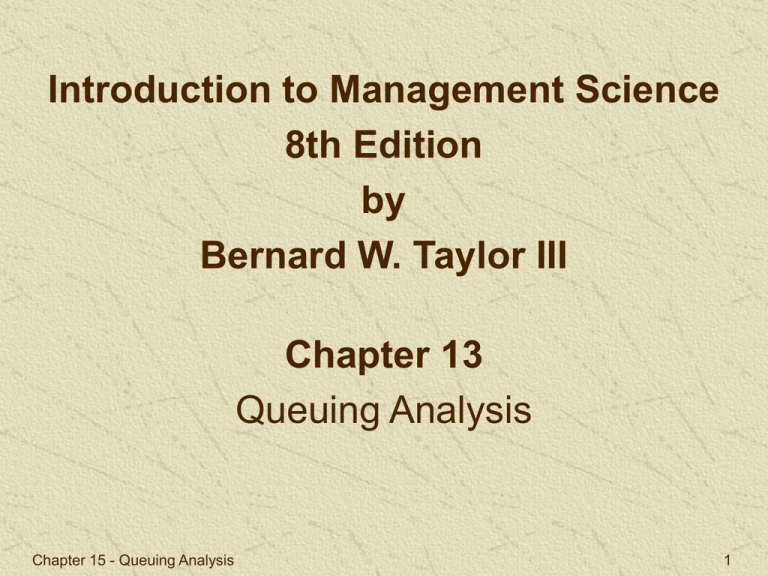
Introduction to Management Science 8th Edition by Bernard W. Taylor III Chapter 13 Queuing Analysis Chapter 15 - Queuing Analysis 1 Chapter Topics Elements of Waiting Line Analysis The Single-Server Waiting Line System Undefined and Constant Service Times Finite Queue Length Finite Calling Problem The Multiple-Server Waiting Line Addition Types of Queuing Systems Chapter 15 - Queuing Analysis 2 Overview Significant amount of time spent in waiting lines by people, products, etc. Providing quick service is an important aspect of quality customer service. The basis of waiting line analysis is the trade-off between the cost of improving service and the costs associated with making customers wait. Queuing analysis is a probabilistic form of analysis. The results are referred to as operating characteristics. Results are used by managers of queuing operations to make decisions. Chapter 15 - Queuing Analysis 3 Elements of Waiting Line Analysis Waiting lines form because people or things arrive at a service faster than they can be served. Most operations have sufficient server capacity to handle customers in the long run. Customers however, do not arrive at a constant rate nor are they served in an equal amount of time. Waiting lines are continually increasing and decreasing in length.and approach an average rate of customer arrivals and an average service time, in the long run. Decisions concerning the management of waiting lines are based on these averages for customer arrivals and service times. They are used in formulas to compute operating characteristics of the system which in turn form the basis of decision making. Chapter 15 - Queuing Analysis 4 The Single-Server Waiting Line System (1 of 2) Components of a waiting line system include arrivals (customers), servers, (cash register/operator), customers in line form a waiting line. Factors to consider in analysis: The queue discipline. The nature of the calling population The arrival rate The service rate. Chapter 15 - Queuing Analysis 5 The Single-Server Waiting Line System (2 of 2) Figure 15.1 The Fast Shop Market Queuing System Chapter 15 - Queuing Analysis 6 Single-Server Waiting Line System Component Definitions Queue Discipline: The order in which waiting customers are served. Calling Population: The source of customers (infinite or finite). Arrival Rate: The frequency at which customers arrive at a waiting line according to a probability distribution (frequently described by a Poisson distribution). Service Rate: The average number of customers that can be served during a time period (often described by the negative exponential distribution). Chapter 15 - Queuing Analysis 7 Single-Server Waiting Line System Single-Server Model Assumptions of the basic single-server model: An infinite calling population A first-come, first-served queue discipline Poisson arrival rate Exponential service times Symbology: = the arrival rate (average number of arrivals/time period) = the service rate (average number served/time period) Customers must be served faster than they arrive ( < ) or an infinitely large queue will build up. Chapter 15 - Queuing Analysis 8 Single-Server Waiting Line System Basic Single-Server Queuing Formulas (1 of 2) Probability that no customers are in the queuing system: Po 1 Probability that n customers are in the system: n n Pn Po 1 Average number of customers in system: waiting line: 2 Lq Chapter 15 - Queuing Analysis L and 9 Single-Server Waiting Line System Basic Single-Server Queuing Formulas (2 of 2) Average time customer spends waiting and being served: W 1 L Average time customer spends waiting in the queue: Wq Probability that server is busy (utilization factor): Probability that server is idle: Chapter 15 - Queuing Analysis U I 1U 1 10 Single-Server Waiting Line System Characteristics for Fast Shop Market (1 of 2) = 24 customers per hour arrive at checkout counter = 30 customers per hour can be checked out Po 1 (1 - 24/30) .20 probabilit y of no customers in the system L 24/(30 - 24) 4 customers on the avg in the system 2 Lq (24)2/[30(30 - 24)] 3.2 customers on the avg in the waiting line Chapter 15 - Queuing Analysis 11 Single-Server Waiting Line System Characteristics for Fast Shop Market (2 of 2) W 1 L 1/[30 - 24] 0.167 hour (10 min) avg time in the system per customer Wq 24/[30(30 - 24)] 0.133 hour (8 min) avg time in the waiting line U 24/30 .80 probabilit y server busy, .20 probabilit y server will be idle Chapter 15 - Queuing Analysis 12 Single-Server Waiting Line System Steady-State Operating Characteristics Because of steady-state nature of operating characteristics: Utilization factor, U, must be less than one: U < 1,or / < 1 and < . The ratio of the arrival rate to the service rate must be less than one or, the service rate must be greater than the arrival rate. The server must be able to serve customers faster than the arrival rate in the long run, or waiting line will grow to infinite size. Chapter 15 - Queuing Analysis 13 Single-Server Waiting Line System Effect of Operating Characteristics (1 of 6) Manager wishes to test several alternatives for reducing customer waiting time: Addition of another employee to pack up purchases Addition of another checkout counter. Alternative 1: Addition of an employee (raises service rate from = 30 to = 40 customers per hour). Cost $150 per week, avoids loss of $75 per week for each minute of reduced customer waiting time. System operating characteristics with new parameters: Po = .40 probability of no customers in the system L = 1.5 customers on the average in the queuing system Chapter 15 - Queuing Analysis 14 Single-Server Waiting Line System Effect of Operating Characteristics (2 of 6) System operating characteristics with new parameters (continued): Lq = 0.90 customer on the average in the waiting line W = 0.063 hour average time in the system per customer Wq = 0.038 hour average time in the waiting line per customer U = .60 probability that server is busy and customer must wait I = .40 probability that server is available Average customer waiting time reduced from 8 to 2.25 minutes worth $431.25 per week. Chapter 15 - Queuing Analysis 15 Single-Server Waiting Line System Effect of Operating Characteristics (3 of 6) Alternative 2: Addition of a new checkout counter ($6,000 plus $200 per week for additional cashier). = 24/2 = 12 customers per hour per checkout counter = 30 customers per hour at each counter System operating characteristics with new parameters: Po = .60 probability of no customers in the system L = 0.67 customer in the queuing system Lq = 0.27 customer in the waiting line W = 0.055 hour per customer in the system Wq = 0.022 hour per customer in the waiting line U = .40 probability that a customer must wait I = .60 probability that server is idle Chapter 15 - Queuing Analysis 16 Single-Server Waiting Line System Effect of Operating Characteristics (4 of 6) Savings from reduced waiting time worth $500 per week $200 = $300 net savings per week. After $6,000 recovered, alternative 2 would provide $300 281.25 = $18.75 more savings per week. Chapter 15 - Queuing Analysis 17 Single-Server Waiting Line System Effect of Operating Characteristics (5 of 6) Table 15.1 Operating Characteristics for Each Alternative System Chapter 15 - Queuing Analysis 18 Single-Server Waiting Line System Effect of Operating Characteristics (6 of 6) Figure 15.2 Cost Trade-Offs for Service Levels Chapter 15 - Queuing Analysis 19 Single-Server Waiting Line System Solution with Excel and Excel QM (1 of 2) Exhibit 15.1 Chapter 15 - Queuing Analysis 20 Single-Server Waiting Line System Solution with Excel and Excel QM (2 of 2) Exhibit 15.2 Chapter 15 - Queuing Analysis 21 Single-Server Waiting Line System Solution with QM for Windows Exhibit 15.3 Chapter 15 - Queuing Analysis 22 Single-Server Waiting Line System Undefined and Constant Service Times Constant, rather than exponentially distributed service times, occur with machinery and automated equipment. Constant service times are a special case of the singleserver model with undefined service times. Queuing formulas: Po 1 Lq Wq Lq 2 2 2 / 21 / L Lq Chapter 15 - Queuing Analysis 1 W Wq U 23 Single-Server Waiting Line System Undefined Service Times Example (1 of 2) Data: Single fax machine; arrival rate of 20 users per hour, Poisson distributed; undefined service time with mean of 2 minutes, standard deviation of 4 minutes. Operating characteristics: 1 20 .33 probabilit y that machine not in use Po 1 30 Lq 2 2 2 / 21 / 2 2 2 20 1/15 20 / 30 21 20 / 30 3.33 employees waiting in line 3.33 (20 / 30) L Lq 4.0 employees in line and using the machine Chapter 15 - Queuing Analysis 24 Single-Server Waiting Line System Undefined Service Times Example (2 of 2) Operating characteristics (continued): Wq Lq 3.33 0.1665 hour 10 minutes waiting time 20 1 0.1665 1 0.1998 hour W Wq 30 12 minutes in the system 20 67% machine utilizatio n U 30 Chapter 15 - Queuing Analysis 25 Single-Server Waiting Line System Constant Service Times Formulas In the constant service time model there is no variability in service times; = 0. Substituting = 0 into equations: 2 2 2 2 2 2 2 / / 0 / 2 Lq 21 / 21 / 21 / 2 All remaining formulas are the same as the single-server formulas. Chapter 15 - Queuing Analysis 26 Single-Server Waiting Line System Constant Service Times Example Car wash servicing one car at a time; constant service time of 4.5 minutes; arrival rate of customers of 10 per hour (Poisson distributed). Determine average length of waiting line and average waiting time. = 10 cars per hour, = 60/4.5 = 13.3 cars per hour Lq (10)2 2 1.14 cars waiting 2 ( ) 2(13.3)(13.3 10) Wq Lq 1.14 0.114 hour or 6.84 minutes waiting time 10 Chapter 15 - Queuing Analysis 27 Undefined and Constant Service Times Solution with Excel Exhibit 15.4 Chapter 15 - Queuing Analysis 28 Undefined and Constant Service Times Solution with QM for Windows Exhibit 15.5 Chapter 15 - Queuing Analysis 29 Finite Queue Length In a finite queue, the length of the queue is limited. Operating characteristics, where M is the maximum number in the system: n 1 / for n M Po Pn (Po) 1 ( / )M 1 M 1 / ( M 1 )( / ) L 1 / 1 ( / )M 1 W L (1 PM ) Chapter 15 - Queuing Analysis Lq L (1PM ) 1 Wq W 30 Finite Queue Length Example (1 of 2) Metro Quick Lube single bay service; space for one vehicle in service and three waiting for service; mean time between arrivals of customers is 3 minutes; mean service time is 2 minutes; both inter-arrival times and service times are exponentially distributed; maximum number of vehicles in the system equals 4. Operating characteristics for = 20, = 30, M = 4: Po 1 / 1 20 / 30 .38 probabilit y that system is empty 1 ( / )M 1 1 (20 / 30)5 PM (Po) nM 4 (.38) 20 .076 probabilit y that system is full 30 Chapter 15 - Queuing Analysis 31 Finite Queue Length Example (2 of 2) Average queue lengths and waiting times: M 1 / ( M 1 )( / ) L 1 / 1 ( / )M 1 5 ( 5 )( 20 / 30 ) 20 / 30 L 1.24 cars in the system 1 20 / 30 1 (20 / 30)5 Lq L (1PM ) 1.24 20(1.076) 0.62 cars waiting 30 W L 1.24 0.067 hours waiting in the system (1 PM ) 20(1.076) 1 0.067 1 0.033 hour waiting in line Wq W 30 Chapter 15 - Queuing Analysis 32 Finite Queue Model Example Solution with Excel Exhibit 15.6 Chapter 15 - Queuing Analysis 33 Finite Queue Model Example Solution with QM for Windows Exhibit 15.7 Chapter 15 - Queuing Analysis 34 Finite Calling Population In a finite calling population there is a limited number of potential customers that can call on the system. Operating characteristics for system with Poisson arrival and exponential service times: 1 Po n N N! ( N n)! n0 where N population size, and n 1, 2,...N n Po Pn N! ( N n)! L Lq (1 Po) Chapter 15 - Queuing Analysis Lq N (1 Po) Wq Lq ( N L) 1 W Wq 35 Finite Calling Population Example (1 of 2) Wheelco Manufacturing Company; 20 machines; each machine operates an average of 200 hours before breaking down; average time to repair is 3.6 hours; breakdown rate is Poisson distributed, service time is exponentially distributed. Is repair staff sufficient? = 1/200 hour = .005 per hour = 1/3.6 hour = .2778 per hour N = 20 machines Chapter 15 - Queuing Analysis 36 Finite Calling Population Example (2 of 2) Po 1 .652 n 20 20! .005 (20 n)!.2778 n0 Lq 20 .005 .2778 1.652 .169 machines waiting .005 L .169 (1.652) .520 machines in the system Wq .169 1.74 hours waiting for repair (20 .520)(.005) W 1.74 1 5.33 hours in the system .2778 System seems inadequate. Chapter 15 - Queuing Analysis 37 Finite Calling Population Example Solution with Excel and Excel QM (1 of 2) Exhibit 15.8 Chapter 15 - Queuing Analysis 38 Finite Calling Population Example Solution with Excel and Excel QM (2 of 2) Exhibit 15.9 Chapter 15 - Queuing Analysis 39 Finite Calling Population Example Solution with QM for Windows Exhibit 15.10 Chapter 15 - Queuing Analysis 40 Multiple-Server Waiting Line (1 of 2) In multiple-server models, two or more independent servers in parallel serve a single waiting line. Biggs Department Store service department; first-come, first-served basis. Chapter 15 - Queuing Analysis 41 Multiple-Server Waiting Line (2 of 2) Figure 15.3 Customer Service Queuing System Chapter 15 - Queuing Analysis 42 Multiple-Server Waiting Line Queuing Formulas (1 of 3) Assumptions: First-come first-served queue discipline Poisson arrivals, exponential service times Infinite calling population. Parameter definitions: = arrival rate (average number of arrivals per time period) = the service rate (average number served per time period) per server (channel) c = number of servers c = mean effective service rate for the system (must exceed arrival rate) Chapter 15 - Queuing Analysis 43 Multiple-Server Waiting Line Queuing Formulas (2 of 3) Po 1 probabilit y no customers in system c nc11 1 c c n ! c ! n0 Pn n n 1 Po for n c c!cnc n Po for n c probabilit y of n customers in system Pn 1 n c ( / ) average customers in the system L Po (c 1)!(c )2 W L average time customer spends in the system Chapter 15 - Queuing Analysis 44 Multiple-Server Waiting Line Queuing Formulas (3 of 3) average number of customers in the queue Lq L 1 Lq average time customer is in the queue Wq W c c 1 Pw Po probabilit y customer must wait for service c! c Chapter 15 - Queuing Analysis 45 Multiple-Server Waiting Line Biggs Department Store Example (1 of 2) = 10, = 4, c = 3 1 Po 0 1 2 3 3(4) 1 10 110 1 10 1 10 4 4 4 3(4) 10 0! 4 1 ! 2 ! 3 ! .045 probabilit y of no customers 3 ( 10 )( 4 )( 10 / 4 ) L (.045) 10 4 (3 1)![3(4) 10]2 6 customers on average in service department W 6 10 0.60 hour average customer time in the service department Chapter 15 - Queuing Analysis 46 Multiple-Server Waiting Line Biggs Department Store Example (2 of 2) Lq 6 10 4 3.5 customers on the average waiting to be served Wq 3.5 10 0.35 hour average waiting time in line per customer 3 3(4) (.045) Pw 1 10 3! 4 3(4) 10 .703 probabilit y customer must wait for service Chapter 15 - Queuing Analysis 47 Multiple-Server Waiting Line Solution with Excel Exhibit 15.11 Chapter 15 - Queuing Analysis 48 Multiple-Server Waiting Line Solution with Excel QM Exhibit 15.12 Chapter 15 - Queuing Analysis 49 Multiple-Server Waiting Line Solution with QM for Windows Exhibit 15.13 Chapter 15 - Queuing Analysis 50 Additional Types of Queuing Systems (1 of 2) Figure 15.4 Single Queues with Single and Multiple Servers in Sequence Chapter 15 - Queuing Analysis 51 Additional Types of Queuing Systems (2 of 2) Other items contributing to queuing systems: Systems in which customers balk from entering system, or leave the line (renege). Servers who provide service in other than first-come, first-served manner Service times that are not exponentially distributed or are undefined or constant Arrival rates that are not Poisson distributed Jockeying (i.e., moving between queues) Chapter 15 - Queuing Analysis 52 Example Problem Solution (1 of 5) Problem Statement: Citizens Northern Savings Bank loan officer customer interviews. Customer arrival rate of four per hour, Poisson distributed; officer interview service time of 12 minutes per customer. Determine operating characteristics for this system. Additional officer creating a multiple-server queuing system with two channels. Determine operating characteristics for this system. Chapter 15 - Queuing Analysis 53 Example Problem Solution (2 of 5) Solution: Step 1: Determine Operating Characteristics for the SingleServer System = 4 customers per hour arrive, = 5 customers per hour are served Po = (1 - / ) = ( 1 – 4 / 5) = .20 probability of no customers in the system L = / ( - ) = 4 / (5 - 4) = 4 customers on average in the queuing system Lq = 2 / ( - ) = 42 / 5(5 - 4) = 3.2 customers on average in the waiting line Chapter 15 - Queuing Analysis 54 Example Problem Solution (3 of 5) Step 1 (continued): W = 1 / ( - ) = 1 / (5 - 4) = 1 hour on average in the system Wq = / (u - ) = 4 / 5(5 - 4) = 0.80 hour (48 minutes) average time in the waiting line Pw = / = 4 / 5 = .80 probability the new accounts officer is busy and a customer must wait Chapter 15 - Queuing Analysis 55 Example Problem Solution (4 of 5) Step 2: Determine the Operating Characteristics for the Multiple-Server System. = 4 customers per hour arrive; = 5 customers per hour served; c = 2 servers 1 Po n c c n c 11 1 n! c! c n 0 .429 probabilit y no customers in system c ) / ( Po L (c 1)!(c )2 0.952 average number of customers in the system Chapter 15 - Queuing Analysis 56 Example Problem Solution (5 of 5) Step 2 (continued): Lq L 0.152 average number of customers in the queue 1 Lq Wq W 0.038 hour average time customer is in the queue c 1 Pw c Po c! c .229 probabilit y customer must wait for service Chapter 15 - Queuing Analysis 57 Chapter 15 - Queuing Analysis 58
